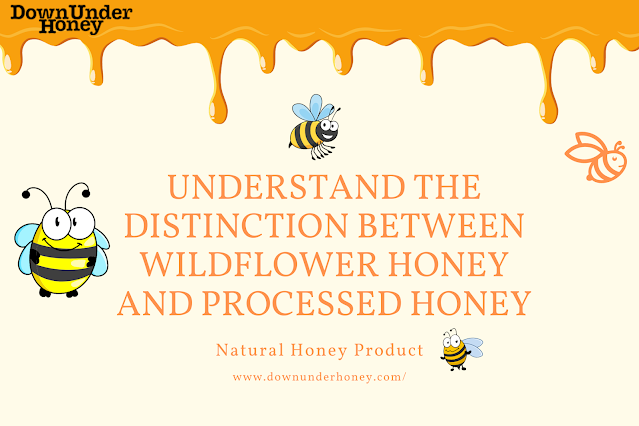The distinction between wildflower honey and processed honey is often misunderstood. This essay will dispel common misconceptions about these two honey varieties and explain the differences between them. Wildflower honey is a form of honey made from a variety of wildflowers.
And has a more complex taste and texture and is often more expensive than processed honey. On the other hand, processed honey is honey that has been extracted from the pack and has undergone some processing.
Raw honey is processed differently than ordinary honey. Beehives produce raw honey. Honey that hasn't been heated keeps all of the enzymes, nutrients, and medicinal ingredients suitable for the body. Impurities, fragments of honeycomb, and dead bees are removed from wildflower honey before being distributed over a nylon cloth to remove them.
Wildflower and Processed Honey Taste and Texture?
Processed honey and wildflower honey sometimes taste and appear different due to manufacturing changes. Compared to processed honey, wildflower honey is more transparent and has a more consistent taste. It's especially true for large-scale commercial production, designed to produce thousands of honey bottles that all look and taste the same.
As previously stated, wildflower honey is made from a wide variety of blossoms. As a result, you'll notice that its flavor isn't consistent throughout the summer.
It is messy because raw honey cannot remove minute honeycomb particles without additional filtration. The crystallization process, which is more likely in raw honey due to the lack of processing, may enhance this appearance. (By slowly heating a honey container in a hot water bath, and can reverse crystallization.)
Because the various plants utilized to generate the nectar lend a particular flavor to the honey, processed honey comes in multiple flavors. Because much of the pollen, which is the critical element that contributes to the taste of honey, is filtered out during processing, regular honey has less flavor.
When honeybees go out to collect nectar, the flavor varies on which species are blooming. They also collect pollen to return to the group at that precise time.
People believe that the difference between wildflower honey and processed honey is negligible. Organic honey relieves constipation and is used as an over-the-counter medication for various burns and wounds. Organic wildflower honey is an effective cough treatment in a study. Raw honey boosts immunity, gives you more energy, and aids weight loss.
Because it contains bee pollen, it is the healthiest honey. Pollen is a substance collected by bees from flowers. Vitamins, amino acids, fatty acids, various other micronutrients, and antioxidants are all found in bee pollen, making it vital. This honey has nutrients that are not present in processed honey.
Honey that is readily available on the market is rarely organic. Honey that has been processed or over-pasteurized has a thin consistency. It is filtered and processed many times to give it a transparent, presentable structure. Honey that has been processed offers little to no health advantages.
Is Wildflower Honey Safe to eat?
Now that you've established that wildflower honey is genuine, the subsequent logical inquiry is how long it lasts.
Even though raw honey's physical and chemical makeup varies, you should always try to keep a jar on hand.
The honey will begin to crystallize from the bottom up after a few months. But don't panic. It is just the glucose in the mixture solidifying into sugar.
If and when it crystallizes, immerse the jar in a container of warm water to hydrate the sugar grains. The honey will still be safe to eat in either case.
There may be chemical changes in its color and aroma, but don't get too worked up. Natural honey has antimicrobial characteristics across the board, making it exceedingly unlikely that anything unusual - or moldy - would grow in your jar.
If your honey comes into contact with wetness, you should be cautious. It may start to ferment in that circumstances, and no one wants to drink honey beer.
Remember to preserve your wildflower honey in a clean, moisture-free container to ensure it lasts for years.
Is Wildflower Honey Good for You?
Wildflower honey is an excellent supplement to any diet because of its high concentration of vital ingredients like digestive enzymes, minerals, and antioxidants. Nutritionists recognize it for its advantages in the following areas:
1. Anti-inflammatory Control:
Wildflower honey's anti-inflammatory, anti-microbial, and analgesic benefits are well-known, as are those of many other raw honey varieties.
These features make it an excellent option for pain reduction and the treatment and disinfection of wounds. It's also high in heart-healthy antioxidants, which can help prevent cardiac arrest, strokes, and other associated diseases.
2. Immunity and Resistance:
The high antioxidant content of wildflower honey is essential for cell maintenance and anti-aging. These substances are also beneficial for boosting the immune system and combating the common cold and flu symptoms.
3. Digestion and Weight Loss:
Honey is a natural source of carbohydrates that is great for boosting energy levels. Organic combinations, such as wildflower honey are often high in digestive enzymes, which aid in the smooth operation of the digestive tract. Better digestion translates to a healthier metabolism, one of the critical areas where people struggle to lose weight. Wildflower honey covers the canal lining and relieves the symptoms of hepatitis.

Comments
Post a Comment